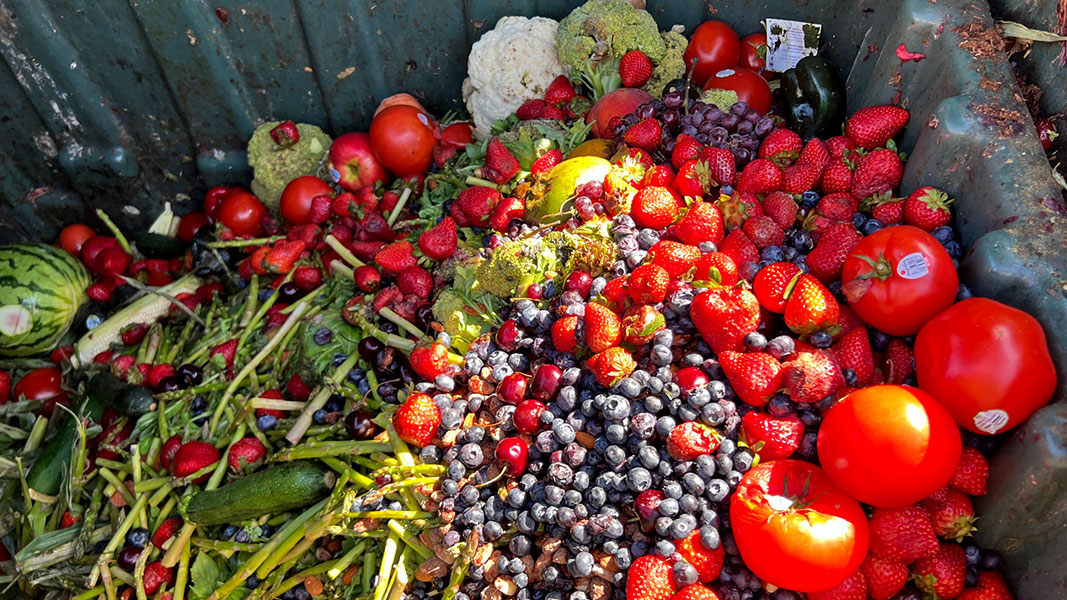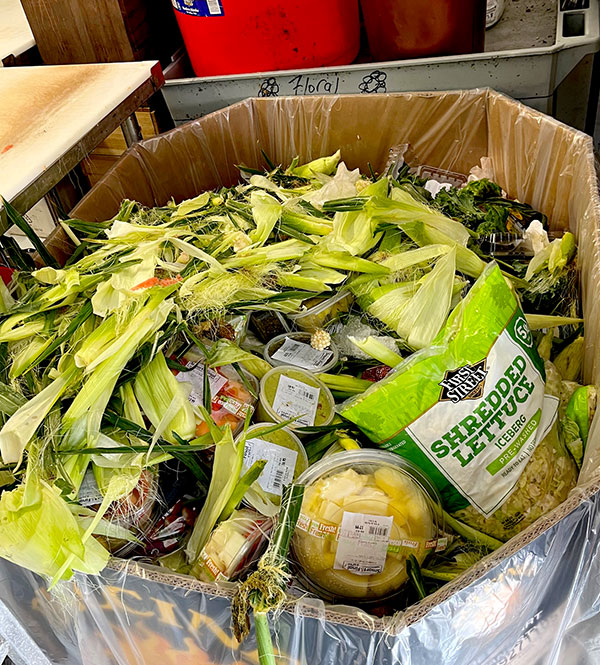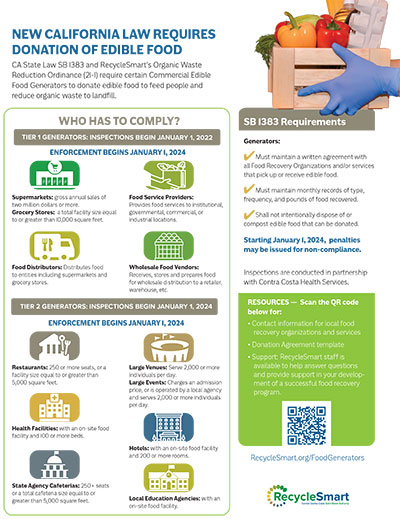Top: Solana Center provides assistance to food businesses in San Diego County (CA) to reduce disposal of food.
Emma Palmer
California finds itself at the forefront of large-scale, statewide, long-term waste reduction targeted at mitigating climate disaster through mandated organics recycling. SB 1383, born out of California’s Short-Lived Climate Pollutant Reduction Strategy, required jurisdictions to begin implementation in 2022 and take action against noncompliant entities by 2024. The San Diego region promptly began tackling the California Department of Resource Recycling and Recovery’s (CalRecycle) recommended stages of implementation, as follows: Provide organics collection services to all residents and businesses; establish an edible food recovery program; conduct education and outreach; procure organic waste products; and plan capacity for managing surplus food.
The San Diego region generates an estimated 600,000 tons/year of excess food. With commercial processing capacity (anaerobic digestion and composting) to manage less than 20% of all the surplus food discarded, the County needs solutions to reduce and rescue as much food waste as possible. San Diego County’s 19 jurisdictions – including the County and 18 cities – worked with various organizations to establish a multidirectional and localized approach toward compliance. Solana Center for Environmental Innovation (Solana Center), a nonprofit supporting the effort, has firmly established its position as a leading authority over local organics recycling through nearly 40 years of work. Jurisdictions throughout San Diego County rely upon this expertise in tackling SB 1383 rollout.
Solana Center provided SB 1383 compliance services to 80% of the region’s jurisdictions, from classifying businesses by type (Tier 1 and Tier 2, defined by CalRecycle) to business inspections and technical assistance. Tier 1 businesses, such as grocery stores and wholesale food vendors, typically have more produce, fresh grocery, and shelf-stable foods; Tier 2 businesses, such as restaurants, hotels and health facilities, typically have more prepared food (see Figure 1). Compliance services work is completed by Solana Center’s Environmental Solutions division, led by Director Mallika Sen.
Solana Center’s experience and findings offer valuable insights about the future of environmental policy — the various struggles of procurement, the diversity of solutions, and the wary, but grounded, optimism for successful organics recycling and food redistribution on a much larger scale.
Insights from Data Modeling
Initially, on behalf of 10 cities, Solana Center categorized their businesses as Tier 1 and Tier 2. The tier classification is relevant because different types and sizes of businesses generate disparate amounts of organic waste and recoverable goods and therefore have distinct profiles in their potential for diversion and donation.
CalRecycle and San Diego County each created models based on available business data to estimate food surplus generation by tier. Using the County’s model, Solana Center found that of all the excess food generated by Tier 1 businesses, an estimated 39% is edible, as compared with 11% edible excess from Tier 2 businesses. Solana Center believes this huge difference is because food retailers (Tier 1) sell more unprepared foods, which are less perishable and therefore more readily rescued than the prepared meals from food service businesses (Tier 2). This aligns with empirical findings from the Pacific Coast Food Waste Collaborative, which estimates that unsold prepared foods from grocers amounts to only 10% of excess food; the remainder is more shelf-stable. The significant takeaway is that the strategy for recovering the most food for people is to focus on Tier 1 business outreach, where the models indicate that 24,000 meals per business are discarded each year.
Insights From Business Visits
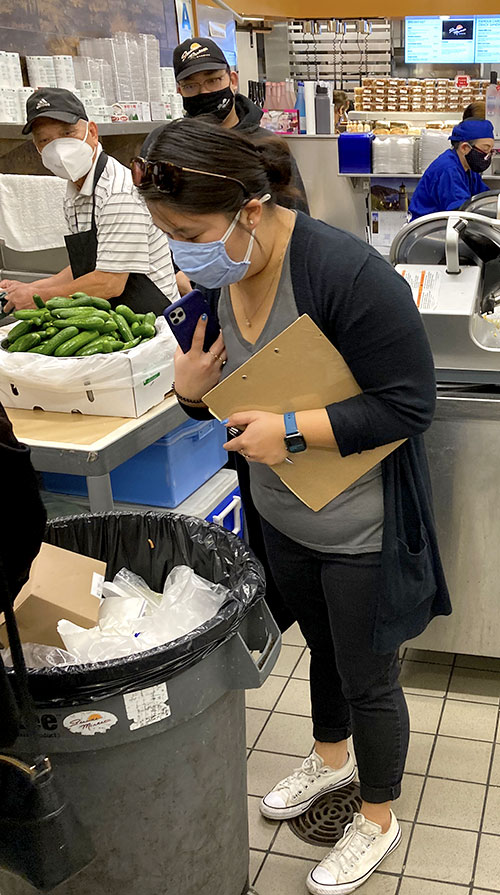
Solana Center staff provide technical assistance on integrating proper recovery and organics recycling into their common practices.
Achieving a reliable and consistent surplus food diversion system is a two-pronged task that involves rescuing edible food and recycling inedible organic waste. Although Tier 1 and Tier 2 entities generate different kinds and amounts of waste, they share common pain points in their attempts to manage it. Solana Center finds that the biggest obstacle in implementing SB 1383 is a general lack of awareness regarding both rescuing and recycling food. Entities that will, by 2024, be held accountable for their waste failures are currently unaware in a wide variety of ways. Many businesses do not know about SB 1383, what it entails, or that they could be fined for noncompliance. Moreover, a large number of businesses do not know how to set up organic waste recycling and recovery systems. Very few businesses are recycling and recovering properly; most are not recycling and recovering at all.
Businesses face numerous obstacles in tackling SB 1383 requirements. Among those expressing the desire to learn about SB 1383 and establish a compliant system, three pain points stood out as consistent roadblocks.
Pain Point #1 – Impact on Operations: Allocating time, funds, and labor to cultivating a recovery and recycling system for a piece of legislation they are either unaware of, or that seems to be a problem in the distant future, appears to be an unnecessary burden on day-to-day operations. Generally speaking, businesses are far more concerned by their immediate problems. The impact on already stressed operations is too great a cost for many businesses.
Pain Point #2 – COVID Realities: A concurrent complaint is that the state and jurisdictions are tone deaf to COVID realities. Businesses are barely recovering from, or more often, still struggling with, pandemic-related constraints, including labor shortages, supply chain issues, and inflation increasing the cost of running a business. As before, these are burdens too pertinent to ignore.
Pain Point #3 – Guidance Needed: Lastly, businesses largely require a “show me how” tutorial on integrating proper recovery and organics recycling into their common practices: Food scrap bins in the kitchens and dishwashing areas, formalized partnerships with recovery agencies, and well-trained staff.
Fortunately, among the plethora of complications and boundaries, early adopters of organic waste procedures and successful interactions between Solana Center and businesses demonstrate the pathway toward progress. Through a two-fold approach tackling education and incentivization, jurisdictions should find that proper SB 1383 compliance is not out of reach, nor is it a weighty burden on local businesses.
Education
Education starts with resources. Cities have print and electronic information about the law. These are good to have on hand. Often, Solana Center found that when not accompanied by an in-person visit, written resources are neglected.
Those who will be held accountable for the legislation’s requirements must be well-informed on the logistics of the bill, the timeline, and the recommended steps towards individual implementation. Further, Solana Center finds that improving businesses’ understanding of the social and environmental impacts of wasted food through education results in greater success with adoption of organics recycling and food recovery processes. Solana Center created videos for peer-to-peer experience sharing, such as short interviews with local business owners who successfully implemented new procedures for food waste disposal, as positive reinforcement.
Incentives
Perhaps more powerful than education is incentivization, as entities will not necessarily see the positive environmental impact of their organic waste reduction efforts. Encouragement might come in the form of witnessing a positive impact, especially a monetary one, within their business. A strong incentive for grocery stores and sustainable local restaurants is that, by tracking food waste, they can identify areas to reduce costs. If a singular type of produce or a specific item on dinner plates is consistently going to waste, owners reduce their spending and their waste by adjusting how much they order or prepare.
One innovative grocery store chain has gleaning volunteers sort surplus produce at their grocery sites before food is sent to recovery agencies. The grocer’s four stores are now rescuing 1,000 pounds/week not previously captured. In this case, the grocer is saving labor and learning from the sorted items, while more food is being recovered. In some cases, hauling services can even be downsized.
Other incentives include subsidized back-of-house sorting bins and food donation tax credits. Ultimately, the looming threat of fines for noncompliance is also a strong incentive. Businesses, whether they like it or not, will forcibly adopt organics recycling and recovery efforts just as they wearily adopted plastic utensil bans and plastic bag bans.
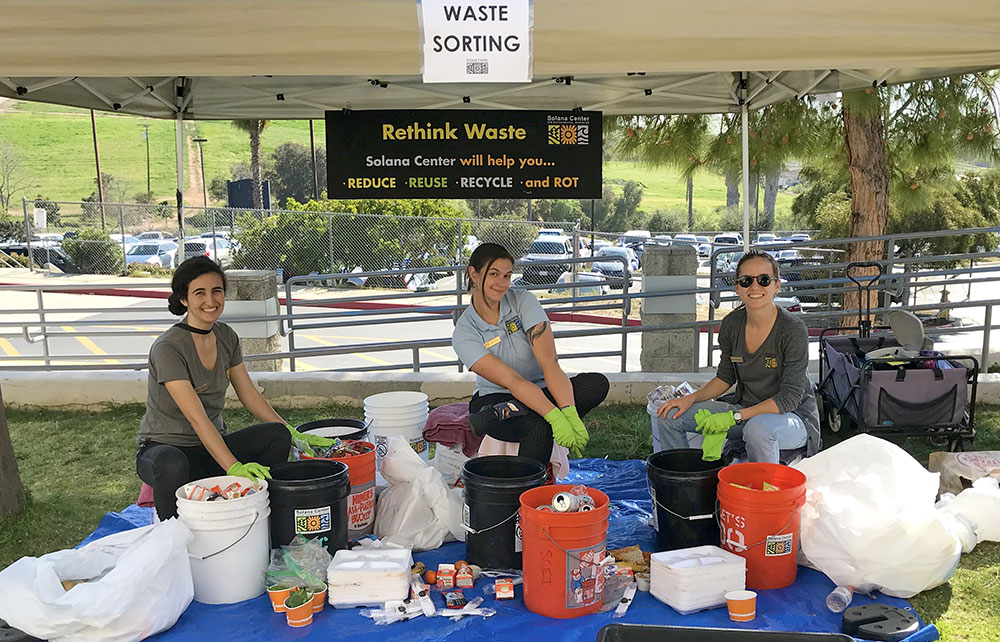
Solana Center staff audits waste streams to help identify opportunities for food recovery and reduction in the amount of food that gets wasted. Photos courtesy of Solana Center for Environmental Innovation.
Positive Direction
Solana Center has identified current obstacles, and cultivated parallel solutions, to augment CalRecycle’s vision for a model organic material recycling system. However, nuanced pain points will arise as SB 1383 is deeper integrated into Californian jurisdictions’ waste management practices. Regardless, it is an important and visionary step toward developing a system which one day might be the foundation for other state laws or a national law. Field work by Solana Center brings awareness of the environmental damage done by landfilled food waste. Implemented as envisioned, California’s SB 1383 will reduce greenhouse gas emissions, create compost and renewable natural gas, and feed food insecure populations. It is not a stretch to imagine. It is here, and it is doable.
Emma Palmer is a recent graduate of University of California, San Diego and volunteer researcher for the Solana Center for Environmental Innovation. She intends to pursue a Ph.D. in environmental policy with a specific focus on organic waste solutions.


